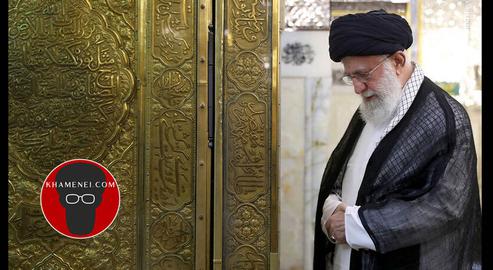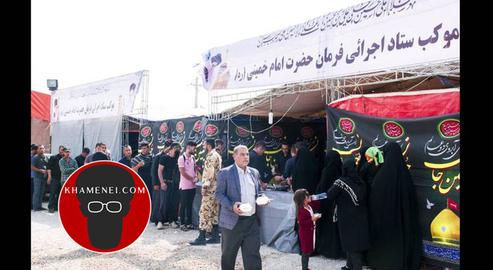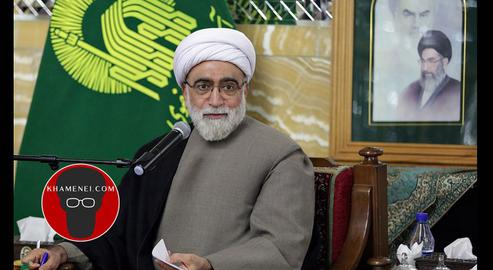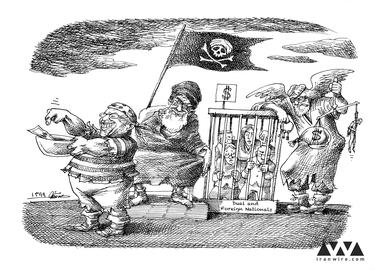Khamenei.com is a review of Ayatollah Ali Khamenei’s 31-year record as Supreme Leader of the Islamic Republic. Khamenei is one of the world’s most secretive and unknown leaders. Details on his personal life are scant and, except for his son Mojtaba, whose name has been in Iran’s news only in recent years, media outlets have seldom published any reports or photographs of his family.
But the mystery does not only surround his personal and family life. Now, three decades after he became the most powerful individual in the Islamic Republic, videos have come to light that reveal his election as Supreme Leader by Iran’s Assembly of Experts was meant to be a temporary measure.
Business groups and economic institutions under the control of the Supreme Leader are as secretive as their master. The financial dealings, profits and losses of these bodies are all secrets, and their operations have never been transparent. The Supreme Leader refuses to act transparently in politics too and has shunned taking direct responsibility whenever possible.
IranWire’s new Khamenei.com series of reports seeks to untangle the mystery of Ayatollah Ali Khamenei.
Analysts and observers who believe that the economic assets and operations under Ayatollah Ali Khamenei’s control is a full-fledged “empire” nevertheless have no clear idea about the figures involved. And how did this empire start? The answer is simple: confiscations.
Khamenei’s economic empire began with the confiscation of the properties of religious minorities branded as “idolators” in Iran, the royal Pahlavi family, their associates and the rich who, after the 1979 Islamic Revolution, decided not to take the risk of remaining in Iran and left their properties behind when they escaped.
During the rule of Ayatollah Ruhollah Khomeini, the founder of the Revolution, who died in 1989, these confiscated properties were managed within a framework of various foundations. Officials have said that the revenues of these foundations was used to help “the deprived and the downtrodden.”
A short time before his passing, Khomeini signed an edict that established an entity called the Executive Headquarters of the Imam's Directive (often referred to simply as “Setad”, Persian for “Headquarters”) that today has an economic reach far beyond the confiscated properties of the old regime, religious minorities, or receiving inheritances without beneficiaries. Setad is now engaged in a variety of wide-ranging activities and is one of the largest economic conglomerates in Iran.
But the Supreme Leader’s economic domain is not limited to Setad and its operations – it includes at least nine large and identifiable economic entities.
- Astan Quds Razavi, a religious foundation that manages endowments and properties of the Imam Reza Shrine, the eighth Shia imam, in Mashhad. In normal times, close to 20 million Shias visit the shrine every year and their donations are another source of income for the foundation.
- Foundation of Martyrs and Veterans Affairs and its affiliate Kowsar Economic Organization. The foundation receives its funding directly from the national budget and gives home loans to disabled veterans and the families of “martyrs”. The Kowsar Organization, meanwhile, is active in many economic sectors, including mining, agriculture, healthcare, electronics, construction, animal husbandry, hotels and other areas.
- Barakat Foundation, the stated mission of which is to carry out development projects and provide employment in deprived and underprivileged areas.
- Mostazafan Foundation, a charitable foundation for Iran’s “downtrodden,” citizens, is the second-largest commercial enterprise in Iran, behind the state-owned National Iranian Oil Company. And it is the biggest holding company in the Middle East.
- Alavi Foundation, a charitable organization that works under the supervision of the Mostazafan Foundation.
- Fifteen Khordad Foundation is another charitable organization that was established to provide financial help to veterans and families of those killed in action.
- Housing Foundation of the Islamic Revolution declares its mission as “providing housing for the underprivileged ... as well as reconstruction of regions suffering damage from natural catastrophes.”
- Imam Khomeini Relief Foundation, which aims to help poor families to gain “financial stability.” It has been active not only in Iran but also in countries such as Pakistan, Somalia, Afghanistan, Kosovo, Iraq, Tajikistan, Syria, Lebanon, Bosnia and Herzegovina.
- Executive Headquarters of Imam's Directive, also known by the weighty title the "Execution of Imam Khomeini's Order.”
Besides Astan Quds Razavi, other religious endowments associated with Shia shrines in Iran also function under the supervision of the Supreme Leader, including the Masoumeh Shrine in Qom, the Shah Abdol-Azim Shrine in Rey, south of Tehran, and the Shah Cheragh Shrine in Shiraz. Their wealth may be more modest than Astan Quds Razavi but they also control sizeable assets and oversee a considerable number of economic activities.
No Transparency across the Board
All these entities in this labyrinthine economic empire have certain features in common.
The first common feature is a lack of transparency. No clear figures on their annual profit and loss, or on their net worth, are available. Whatever is available are estimates by various sources based on partial data. None of these economic entities are required to be transparent or see any need for transparency. They do whatever the Supreme Leader tells them to do and what they do is outside the oversight of supervisory agencies or the media.
Even the Iranian parliament has disenfranchised itself when it comes to supervising or monitoring these economic conglomerates. In 2008, parliament added a provision to its own bylaws that affirms that any investigation of entities under the supervision of the Supreme Leader can only be conducted with his personal approval.
Nor can state agencies – such as the General Inspection Office, the Iranian National Tax Administration or the Supreme Audit Court of Iran – look into the workings of these entities. A major part of auditing economic entities under the supervision of the Supreme Leader has been entrusted to Mofidrahbar Audit to completely separate Khamenei’s economic archipelago from the mainland of the Iranian economy. Mofidrahbar Audit was founded in 1993 with the express purpose providing its services to institutions associated with the Supreme Leader. Roughly 200 companies in this group, active in a wide variety of economic fields, have entrusted their audits to Mofidrahbar.
Under Ayatollah Khamenei, the organizational structure for supervising his conglomerates were gradually transformed from a traditional and simple panel of managers to a full bureaucracy that, according to Reuters, had more than 500 employees in 2013.
The Iranian Constitution, Reinterpreted
“The economy of the Islamic Republic of Iran is to consist of three sectors: state, cooperative, and private, and is to be based on systematic and sound planning,” states Article 44 of the Islamic Republic Constitution. “The [precise] scope of each of these sectors, as well as the regulations and conditions governing their operation, will be specified by law.” Clause 1 of Article 110 of the constitution, however, allows the Supreme Leader to “delineate the general policies of the Islamic Republic of Iran after consultation with the Nation's Expediency Council.”
In 2014, Khamenei issued a “strategic” proclamation (Persian link) addressed to the heads of the three branches of government and the chairman of the Expediency Council, purportedly to facilitate and speed up Iran’s economic development through strengthening private and cooperative sectors. But in practice it allowed the economic entities under his supervision to expand.
In a 2013 report by Reuters, based on an analysis of statements by officials of Setad, data from the Tehran Stock Exchange and company websites, and information from the US Treasury Department, it was estimated that Setad’s holdings of real estate, corporate stakes and other assets was worth about $95 billion.
Even if accurate, however, this figure is now out of date. Since 2013 Setad has been fundamentally reorganized and has exponentially increased its visible and secret economic activities. Part of this expansion was achieved through the Tadbir Investment Group and by expanding the activities of Barakat Foundation. By entering the stock market, Barakat Foundation has become one of the main players in the stock market, and has enabled the Supreme Leader’s economic empire to become a shareholder in areas such as pharmaceuticals, financial and banking services and communications.
In its June 2013 statement, the US Treasury announced that it had sanctioned “37 ostensibly private businesses, many of which are front companies” for Setad. And, quoting a US Treasury spokesman, Reuters reported that the sanctions applied only to entities where Setad “owns 50 percent or more of a company." But Reuters also identified at least 24 other public companies in which Setad – or a company it had invested in – held less than 50 percent but were effectively run by the “headquarters.” Reuters estimated that these 24 companies were worth more than $3.4 billion.
Reuters also identified 14 companies that Setad had invested in – directly or through other companies – that could not be valued because they were not publicly traded.
Bigger than Oil Exports
“All told,” according to the Reuters report, “Reuters was able to identify about $95 billion in property and corporate assets controlled by [Setad]. That amount is roughly 40 percent bigger than the country's total oil exports last year [2012]. It also surpasses independent historians' estimates of the late shah's wealth.”
The Tadbir Investment Group’s mission is to organize market investments by Setad. Tadbir Energy Development Group is responsible for investments in the energy industry and it holds shares in companies such as Pars Oil, Persia Oil and Gas Industry Development, Ghaed Bassir Petrochemical Products, Parsian Gas Refinery, Parsian Gas Refinery and a number of other oil, gas and petrochemical firms.
The communication subsidiary of Setad is Mobin Electronic Development Company. In 2009, under the umbrella of Mobin Trust Consortium, this company succeeded in purchasing 51 percent of the Telecommunication Company of Iran for $7.8 billion. Besides the Telecommunication Company of Iran, other holdings of Setad in telecoms include the mobile network operator Taliya Communications, Aseman Media, Raymon Media, Mobin One Kish, Iranian Rahkam Communication, and Mobin Khavar Technology and a number of others.
In agroindustry, Setad’s activities are managed by Tadbir Noandishan Agro Industrial, a holding company that controls companies such as Zarrin Kesht Paydar, Tadbir Zarrin Dam Paydar, Tus Modabber Agricultural and Dezful Martyrs Sugar.
Setad is also active in the mining industry. The holding company Tadbir Mine and Industry Development owns Karoon Phosphate Products Complex and Ayandegaran Industry and Mine, among other subsidiaries, on behalf of the Setad conglomerate.
But, in recent years, two of the sectors that Setad has been especially interested in are investments and financial services. Tadbir Investment Company has been tasked with managing Setad’s interests here and it carries this out through a set of companies including Pardis Investments, Leasing Iran, Iran and Shargh Company, Tadbir-Garan Farda Brokerage firm, and Rey Investment Company. According to the US Treasury, “as of late December 2010, Rey Investment Company was worth approximately $40 billion.”
There is also Barekat Pharmaceutical Group, which holds more than 20 pharmaceutical companies for Setad, such as Atipharmed, Sobhan Darou, Alborz Darou, Toliddaru and many other names familiar to Iranians. According to Barekat Pharmaceutical Group’s own website, as was reported by Reuters, this holding company had more than $1 billion in sales in 2011.
Two other holding companies, the Tadbir Management Consultants and Strategic Studies Group and the Tadbir Construction and Development Group, are in charge of managing Setad’s economic activities in other sectors through their subsidiaries.
Twelve years ago the CEO of Setad’s Properties Organization estimated that the value of the real estate alone, under its control, was $52 billion. Also, in a report published in 1989 by the International Journal of Middle East Studies, in 1982 Setad owned 2,786 pieces of real estate. These figures change year by year.
Mission: Expand!
Setad is the most important economic conglomerate under the control of the Supreme Leader. But its importance lies not only in its financial value or its business activities but also in its ongoing mission: to expand the empire.
When it comes to the value of its holdings or the variety of its business activities, Astan Quds Razavi is no less active or important than Setad, and it enjoys a measure of independence in its activities.
On the traditional side, Astan Quds Razavi always enjoys profitable income from its properties and donations by Shia pilgrims to its shrine. But it also owns many industrial companies and some agro-industrial businesses. Like other entities under the supervision of the Supreme Leader, its ledgers are opaque and it is not clear what taxes it pays.
It has been reported that Astan owns 89 companies and, in 2004, it streamlined its economic activities by launching the Razavi Economic Organization. Like Setad, this organization is active in eight economic sectors – construction, automobile manufacturing, energy, information technology, food and drugs, finance, commerce and agriculture – but it also owns properties and lands across Iran with an estimated worth of more than $150 billion. The estimate, however, is no doubt off the mark; it could be lower, or even higher.
Another outsize economic entity under the supervision of the Supreme Leader is the Mostazafan Foundation (Foundation of the Oppressed) which was founded after the 1979 Revolution by confiscating the properties and assets of the deposed royal family and their associates.
In 1989, this foundation owned more than 800 companies and businesses. The number fell to less than 140 in 2009. The reason for this drop was twofold: some companies were sold and others went out of business.
Even the CEO Does Not Know
In a 2017 interview, Mohammad Saeedi Kia, CEO of the Mostazafan Foundation at the time, confessed that, because of the complexity of the valuations and cases pending before Iran's courts, he had no accurate estimate of Mostazafan’s worth. But according to its year-end financial statement in 2016, the foundation was worth more than 56 trillion tomans (close to $170 billion in 2016 currency prices).
In the summer of 2020, Parviz Fattah, current CEO of the foundation, announced that, in 2019, Mostazafan had a gross income of 36 trillion tomans (close to $8.6 billion) and a pre-tax profit of seven trillion tomans (over $1.6 billion). The collapse in Iran’s currency value contributed to the divergence in US dollar conversions since the 2016 valuation.
There are also other large economic entities under the supervision of the Supreme Leader. But to this economic empire we must add economic entities owned by the military. The heads of these entities are also appointed by the Supreme Leader and their ledgers are also opaque.
According to the reformist politician Behzad Nabavi, former minister of heavy industries and former deputy chairman of parliament, entities under the supervision of the Supreme Leader, military or not, account for 60 percent of gross domestic product of Iran. Mohsen Safaei Farahani, another reformist politician and a former member of parliament, puts the share of this economic empire at 65 percent of GDP.
In contrast, Mohammad Javad Iravani, a deputy auditor in Ayatollah Khamenei’s office, claims that the share of these entities in the Iranian economy is less than 0.8 percent of the GDP although he concedes that they can have a disproportionate impact on the Iranian economy. Since none of the economic entities under the supervision of the Supreme Leader acts in a transparent way, fact checking these numbers is next to impossible.
Also in the Series:
Nuclear Confrontation, Khamenei’s Gift to Iran, 19 September 2020
The Overnight Ayatollah: Khamenei's Fight to Become a Spiritual Leader, 16 September 2020
Ruhollah Khomeini and Ali Khamenei: An Ayatollah and his Acolyte, 14 September 2020
How Did Khamenei Become Supreme Leader?, 11 September 2020
visit the accountability section
In this section of Iran Wire, you can contact the officials and launch your campaign for various problems




























comments